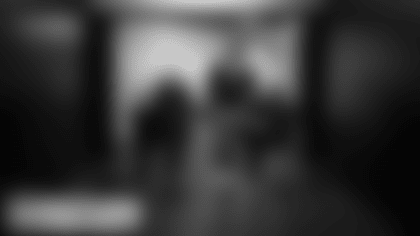(Sixth in a series)
Alex Smith is the example for both sides of the argument.
Alex Smith, at the time, was the starting quarterback for the San Francisco 49ers; to be more precise, the starting quarterback with the 70.0 completion percentage and the 104.1 passer rating for the 6-2 San Francisco 49ers. The second half of the 49ers' schedule opened with an intradivision game against the St. Louis Rams, and Smith began that day by completing 7-of-8 for 72 yards and a touchdown – but somewhere along the way he reported a hit that caused his vision to blur to the team's medical personnel. The on-site examination then revealed that Smith had sustained a concussion, which meant the protocol for return-to-play kicked in, and Smith ended up being sidelined for the next two weeks. Smith has shown no residual effects of that concussion, and based on every bit of medical knowledge currently available, he will suffer no long-term effects of what happened on the field that day against the Rams.
"See, it works," say league officials and doctors.
Alex Smith, at the time, was the starting quarterback for the San Francisco 49ers; to be more precise, the starting quarterback with the 70.0 completion percentage and the 104.1 passer rating for the 6-2 San Francisco 49ers. The second half of the 49ers' schedule opened with an intradivision game against the St. Louis Rams, and Smith began that day by completing 7-of-8 for 72 yards and a touchdown – but somewhere along the way he reported a hit that caused his vision to blur to the team's medical personnel. The on-site examination then revealed that Smith had sustained a concussion, which meant the protocol for return-to-play kicked in, and Smith ended up being sidelined for the next two weeks. During those two weeks, a second-year quarterback named Colin Kaepernick replaced Smith, and after he put up a 66.7 completion percentage and a 110.9 passer rating to go along with dynamic rushing skills, Coach Jim Harbaugh gave him Smith's job. The 49ers ended up in Super Bowl XLVII, Kaepernick ended up as the NFL's Next Big Thing, and Smith ended up in Kansas City with the 2-14 Chiefs.
"See what happens when you report getting dinged?" says every player who's paranoid about losing his starting job.
The NFL Sideline Concussion Assessment Tool was instituted for the 2012 season, and it now is a part of a mandatory procedure that includes a baseline test done during physical examinations at the start of the preseason. What's new for 2013 is that this now will be used in app form by all 32 teams, with the idea that being able to compare the baseline test with the post-injury test in real time will help speed diagnosis and provide trainers and doctors with the evidence they need when making the decision whether to remove the player from the game.
During the 2013 NFL Scouting Combine, Dr. Margot Putukian and Dr. Stanley Herring did a demonstration for the assembled media to show exactly how this app would be used on an NFL sideline during a game.
Both Putukian and Herring are members of the NFL Head, Neck & Spine Committee. Putukian also is the Head Team Physician for Princeton University, and Herring is the Team Physician of the Seattle Seahawks. And at a very early stage of the demonstration, Putukian explained that the app is not the be-all, end-all.
"I think we have to be careful," Putukian said. "There are going to be athletes who have concussions that this tool does not pick up. It's an elusive diagnosis."
But taking a baseline test at the start of each preseason and then using those results to assess the athlete on site is the best test currently available, but it's as much about the observations made by the doctor as it is about the app itself.
"The first thing is to determine there's not a problem that requires immediate transport to a hospital," said Herring. "Was there an immediate threat to you that might make me decide to send you to a hospital? Were you knocked unconscious? Did you seem more confused than usual? Also, (I would) find out if you remembered the play? Do you remember coming to the stadium? Try to ask questions to determine if there was any term of amnesia.
"You go through the rest of the immediate threat questions, and this gives a standardized assessment. Once you get there, there are some go or no-go situations that would be immediate reasons to remove you from play. Look and see if you're becoming more confused, more somnolent, because if you were deteriorating we would immediately take you out. Neck pain, tingling, numbness. Look at your eyes to see if your pupils are equal. Look to see if your arms and legs work symmetrically. These are among the things that lead to an immediate go/no-go decision. If any of those are in play, we would immediately pull you out of the game and save the rest of this exam for later. One 'yes,' and you're done and would not be returned to practice or play."
That part of the evaluation appears below:

"Once we decide to evaluate you at the stadium and not send you to the hospital," said Herring, "I would pull up a form. It would allow me to collect some information right on the iPad either from the sideline or in the locker room."
That form begins with a section already filled out by the player during the preseason as part of his baseline test for that year. After the player has been examined by the team physician and it has been determined a trip to the hospital is not necessary, the player will be asked the questions in the "How do you feel?" category. As he did while filling out this section during his baseline test, the player will be asked to score himself on the following symptoms, on a scale of 1 to 6. The comparison scores from this segment of the baseline test are visible to the doctor for an immediate comparison.

"Are they tempted to lie? It's possible," said Herring, "but our knowledge, our skill, our relationship with the player comes into play. We've also done this as a baseline before the season, and we're also watching his behavior while completing that. Based on the program, I have immediate comparison from the baseline to how he is now in real time. This measures change, and with the baseline we know in real time that there was a change. That's step one."
As the test continues, the answers to the questions become more difficult to fake, it becomes more difficult for the player to try to lie his way back onto the field. That's because the questions require specific answers that easily can be scored as either correct or incorrect, as opposed to questions asked as a means to measure change in how the person feels. These questions come from the sections titled, "SAC/Orientation," "SAC/Word Recall," and "SAC/Concentration." (See below) And everything is scored in terms of correct answers given at that specific time, as well as having the scores from these sections of the test that had been administered during the baseline exam available for immediate comparison.

Then the final portion of the test involves coordination, (see below) and again, an immediate comparison to the individual's baseline scores are available via the app.

But even with all of these tests and the availability of immediate comparisons with the results of the baseline, this is not, as Putukian said, the be-all, end-all.
"An athlete can have a concussion and be able to get through this brief evaluation and 'be normal,'" said Putukian. "Concussions might not present for several minutes, or hours, or even days. This does add some level of standardization in terms of being able to look at an athlete and compare this to his baseline evaluation. But it's not a perfect test. Nor is there one. We don't have one that's a perfect test."
Full PDF Version of NFL Sideline Concussion Assessment Tool: Baseline Test




NEXT: What others are sayingFOOTBALL'S FUTURE: ANOTHER PERSPECTIVEPart 1: Tomlin: Football is a teaching tool for young menPart 2: Many pros allow their boys to playPart 3: Blaming football is easy, not correctPart 4: Ilkin: You know what you signed on forPart 5: USA Football is fighting the fight






